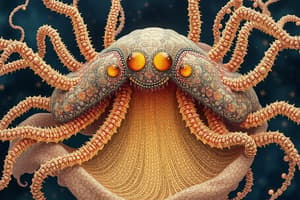Podcast
Questions and Answers
Which classes are under Phylum Ctenophora?
Which classes are under Phylum Ctenophora?
- Cydippida
- Tentaculata (correct)
- Platyctenida
- Nuda (correct)
What are the orders under Class Tentaculata?
What are the orders under Class Tentaculata?
- Cydippida
- Lobata
- Cestida
- All of the above (correct)
What order is under Class Nuda?
What order is under Class Nuda?
Order Beroida
What are the defining characteristics of Phylum Ctenophora?
What are the defining characteristics of Phylum Ctenophora?
What are colloblasts?
What are colloblasts?
What are common names for Phylum Ctenophora?
What are common names for Phylum Ctenophora?
How many species does Phylum Ctenophora have approximately?
How many species does Phylum Ctenophora have approximately?
Ctenophores are bioluminescent and nearly all are predators.
Ctenophores are bioluminescent and nearly all are predators.
There are two parasitic species in Phylum Ctenophora.
There are two parasitic species in Phylum Ctenophora.
What type of symmetry does Phylum Ctenophora exhibit?
What type of symmetry does Phylum Ctenophora exhibit?
Ctenophores have eight plates of fused cilia that resemble combs and move by beating flagella.
Ctenophores have eight plates of fused cilia that resemble combs and move by beating flagella.
Most of the body of Ctenophores is jelly-like mesoglea and covered with sticky mucus.
Most of the body of Ctenophores is jelly-like mesoglea and covered with sticky mucus.
What are colloblasts in Ctenophores?
What are colloblasts in Ctenophores?
What does Euchlora rubra lack instead of colloblasts?
What does Euchlora rubra lack instead of colloblasts?
How does digestion occur in Phylum Ctenophora?
How does digestion occur in Phylum Ctenophora?
The nervous system of Phylum Ctenophora consists of a subepidermal network and statolith that rests on four tufts of balancer cilia.
The nervous system of Phylum Ctenophora consists of a subepidermal network and statolith that rests on four tufts of balancer cilia.
In phylum Ctenophora, all members are gonochoristic.
In phylum Ctenophora, all members are gonochoristic.
In most species of Ctenophores, fertilization is external.
In most species of Ctenophores, fertilization is external.
Ctenophores have free swimming cydippid larvae, and asexual reproduction is very rare.
Ctenophores have free swimming cydippid larvae, and asexual reproduction is very rare.
What do large oral lobes in Class Tentaculata assist with?
What do large oral lobes in Class Tentaculata assist with?
In Class Tentaculata, some tentaculate species closely resemble cydippid larvae except having functional gonads.
In Class Tentaculata, some tentaculate species closely resemble cydippid larvae except having functional gonads.
In other species within Class Tentaculata, the body is somewhat compressed laterally, with only four fully developed comb rows.
In other species within Class Tentaculata, the body is somewhat compressed laterally, with only four fully developed comb rows.
Two pairs of ciliated paddle or tentacle-like structures called ______ assist in capturing prey.
Two pairs of ciliated paddle or tentacle-like structures called ______ assist in capturing prey.
In cestids, the body forms a long ribbon with the mouth and apical sense organ on opposite sides at its midpoint.
In cestids, the body forms a long ribbon with the mouth and apical sense organ on opposite sides at its midpoint.
Some species simply float in the water and others spend their time creeping slowly over solid substrates, using (a) ______ and (b) ______ for locomotion.
Some species simply float in the water and others spend their time creeping slowly over solid substrates, using (a) ______ and (b) ______ for locomotion.
What is Class Nuda characterized by?
What is Class Nuda characterized by?
In Class Nuda, all seven comb rows are well developed.
In Class Nuda, all seven comb rows are well developed.
In Class Nuda, prey are captured and engulfed by (a) ______.
In Class Nuda, prey are captured and engulfed by (a) ______.
What are macrocilia in Ctenophores?
What are macrocilia in Ctenophores?
Flashcards are hidden until you start studying
Study Notes
Phylum Ctenophora Overview
- Ctenophores, commonly known as comb jellies or sea walnuts, are exclusively marine organisms.
- Approximately 150 species exist, exhibiting various shapes such as spherical, ovoid, or elongate.
- Characterized by bioluminescence; most are transparent and predatory.
Classification
- Phylum Ctenophora includes two main classes: Tentaculata and Nuda.
- Class Tentaculata encompasses several orders: Cydippida, Lobata, Cestida, and Platyctenida.
- Class Nuda is represented by a single order, Beroida.
Physical Characteristics
- Defining features include plates of fused cilia arranged in two rows and the presence of colloblasts, which are specialized adhesive cells.
- Tentaculata have large oral lobes covered with mucus and colloblasts for prey capture.
Locomotion and Anatomy
- Ctenophores are distinguished by eight rows of comb-like cilia that facilitate movement.
- Nervous system is structured as a subepidermal network with statoliths resting on four ciliated balancer tufts.
Reproduction and Development
- Most ctenophores are hermaphroditic, with external fertilization common.
- Free-swimming cydippid larvae develop into adult forms, and asexual reproduction is rare.
Feeding Mechanism
- Predatory behavior is executed through tentacles and specialized structures like auricles.
- Species in Class Nuda lack tentacles and rely on muscular lips to capture prey, engaging in extracellular and intracellular digestion.
Mobility
- Different locomotion methods include floating and creeping on substrates, employing pharyngeal cilia and muscular contraction for movement.
- Macrocilia, formed by numerous axonemes, assist in feeding and are located just inside the mouth.
Symmetry and Structure
- Ctenophores exhibit radial or biradial symmetry.
- The body composition includes a jelly-like mesoglea, contributing to its unique structural characteristics.
Special Cases
- Certain species like Euchlora rubra do not possess colloblasts and instead utilize nematocysts for prey capture.
Studying That Suits You
Use AI to generate personalized quizzes and flashcards to suit your learning preferences.




